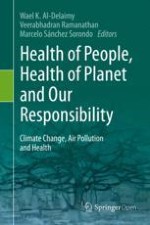The effect of PM
2.5 on atherosclerosis
has been shown in animal models. In one study, 28 mice were fed with normal or high-fat chow and exposed to PM
2.5 or filtered air for 6 h/day, 5 days a week for 6 months. A significant increase in the amount of atherosclerosis, vasoconstrictor response and vessel inflammation was measured in the mice aorta exposed to PM
2.5 (Sung, Wang, Jin, et al.,
2005). The Multi Ethnic-Study of Atherosclerosis and Air Pollution (MESA)
was conducted over 10 years in nine locations from six USA states. A greater degree of coronary calcification in multi-slice CT was determined in subjects exposed to PM
2.5 and nitrogen dioxide. Hypertensive and older subjects were the most vulnerable (Kaufman, Adar, Allen, et al.,
2012; Kaufman, Adar, Barr, et al.,
2016). Significant changes in forearm blood flow have been shown with smoking, which are exacerbated when another variable such as high cholesterol is also present (Heitzer, Yla-Herttuala, Luoma, et al.,
1996). In another study, 31 subjects were exposed to PM
2.5, ozone, their combination, or filtered air. Diastolic blood pressure was lowest in the filtered air group and most significantly elevated in the PM plus ozone group (Brook, Urch, Dvonch, et al.,
2009). In a double-blinded, crossover study, Kristen et al. exposed 45 nonsmoking subjects (age 18–49) to diesel exhaust PM for 2 h or to filtered air (exposure times were separated by 2 weeks). Blood pressure was measured every 30 min during exposure and four times during the first 24 h. Systolic blood pressure was significantly and rapidly increased in the diesel group compared to controls despite the short exposure time (Kristen, Cosselman, Krishnan, Oron, et al.,
2012). Short-term exposure to air pollution outside the laboratory has also been shown to cause acute vascular events. A French study of the gaseous phase of air pollution showed that people aged 55–64 years without prior clinically evident vascular disease, exposed for 1–2 days to increased concentrations of ozone, had a significantly higher risk of developing an acute coronary event (Ruidavets, Cournot, Ferrières, et al.,
2005). Other studies provide extensive evidence of the association between air pollution
and hospital admissions and emergency room consults for vascular events, myocardial infarction, stroke, arrhythmias, and congestive heart failure (Brook, Franklin, Cascio, et al.,
2004; Claeys, Rajagopalan, Nawrot, & Brook,
2017; Forastiere & Agabiti,
2013; Gold & Samet,
2013; Link & Dockery,
2010; Mustafić, Jabre, Caussin, et al.,
2012; Stafoggia, Cesaroni, Peters, et al.,
2014).
Epidemiological data also show that when deaths are compared for each month of the year before and after smoke-free legislation was passed in the USA, a significant reduction in the number of deaths was noted (Pell, Haw, Cobbe, Newby, et al.,
2008). Shah et al. performed a meta-analysis to assess exposure to air pollutants and acute stroke (Shah et al.,
2015). The authors reviewed approximately 100 articles reporting 6.2 million vascular events in 28 countries. A robust association was found between admissions/death from stroke
with both PM and gaseous air pollutants (except for ozone); the strongest association occurred on the day of exposure to PM
2.5. The most significant findings were seen in low- and middle-income countries. Previous studies had shown an association between long-term PM exposure and stroke (Dockery et al.,
1993; Miller, Siscovick, Sheppard, et al.,
2007; Pope, Burnett, Krewski, et al.,
2009). A recent review analyzed the association between air pollution and stroke focusing on the specific subtypes of stroke (hemorrhagic, small and large vessel, cardioembolic), patient’s age, effect of temperature in the cold and warm season, types of pollutants, duration of exposure, and the presence of vascular risk factors or previous vascular events (Estol,
2019).
The Global Burden of Stroke
study by Feigin et al. revealed a significant loss of stroke disability-adjusted life-years (DALYs)
from air pollution among metabolic and behavioral risk factors (Feigin et al.,
2016). The importance of the authors’ findings was showing that 90% of stroke burden is due to modifiable risk factors. Air pollution was the third largest contributor to stroke burden, with 33 million stroke-related
DALYs in 2013. Although the world average of stroke burden attributed to air pollution was 30%, it ranged from 34% in low- to middle-income countries to 10% in high-income countries. Cohen et al. showed that stroke and coronary heart disease represent a large proportion of deaths due to PM
2.5 and have shown a steady and significant increase since 1990 (Cohen et al.,
2017).
The 2017 report by the Lancet Commission on pollution and health provides data in support of pollution being the most important environmental cause of disease and premature death worldwide (Landrigan, Fuller, Acosta, et al.,
2017). Air pollution causes more deaths than water, occupational and soil pollution combined; it results in three times more deaths than HIV, tuberculosis and malaria combined and 15 times more deaths than those caused by war and other violence. In 2015, air pollution accounted for 26% of coronary heart disease deaths and for 23% of stroke deaths, reflecting 21% of cardiovascular deaths overall (Landrigan et al.,
2017). These deaths have an age peak in children under the age of 5 years, although the largest absolute number of deaths occurs over 55 years of age. Because of the significant number of years in age expectancy, the largest number of DALYs lost affect children.
